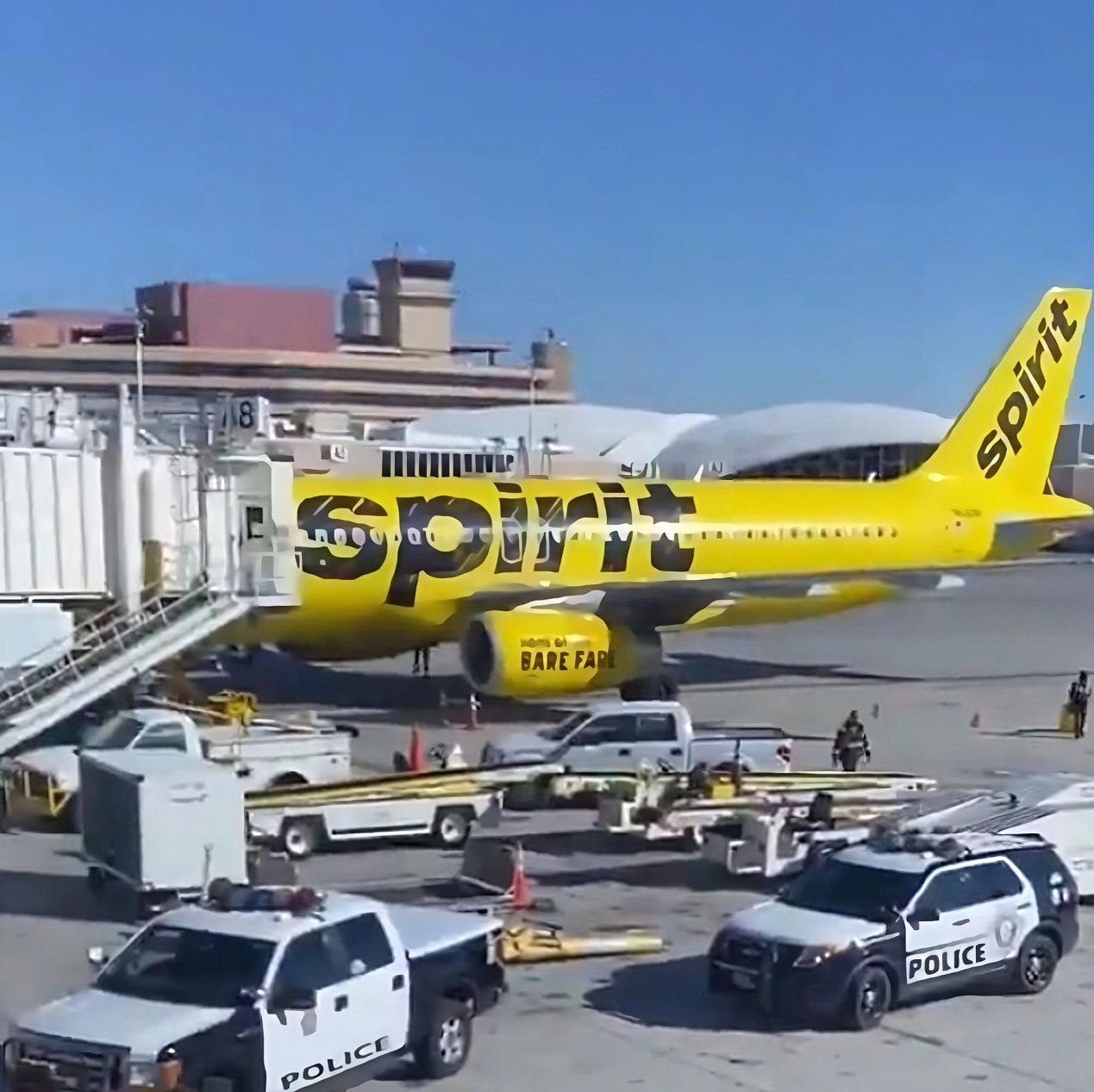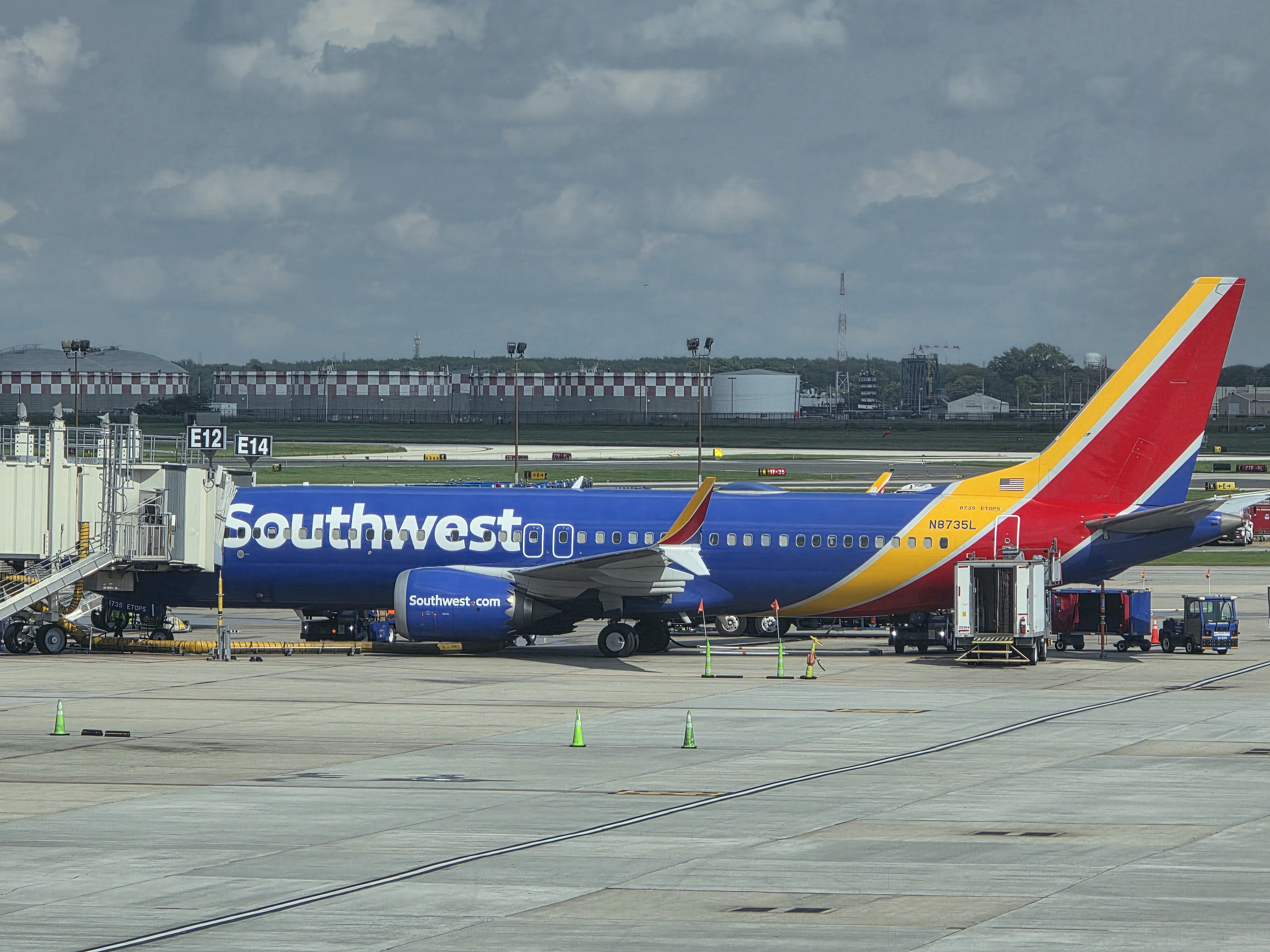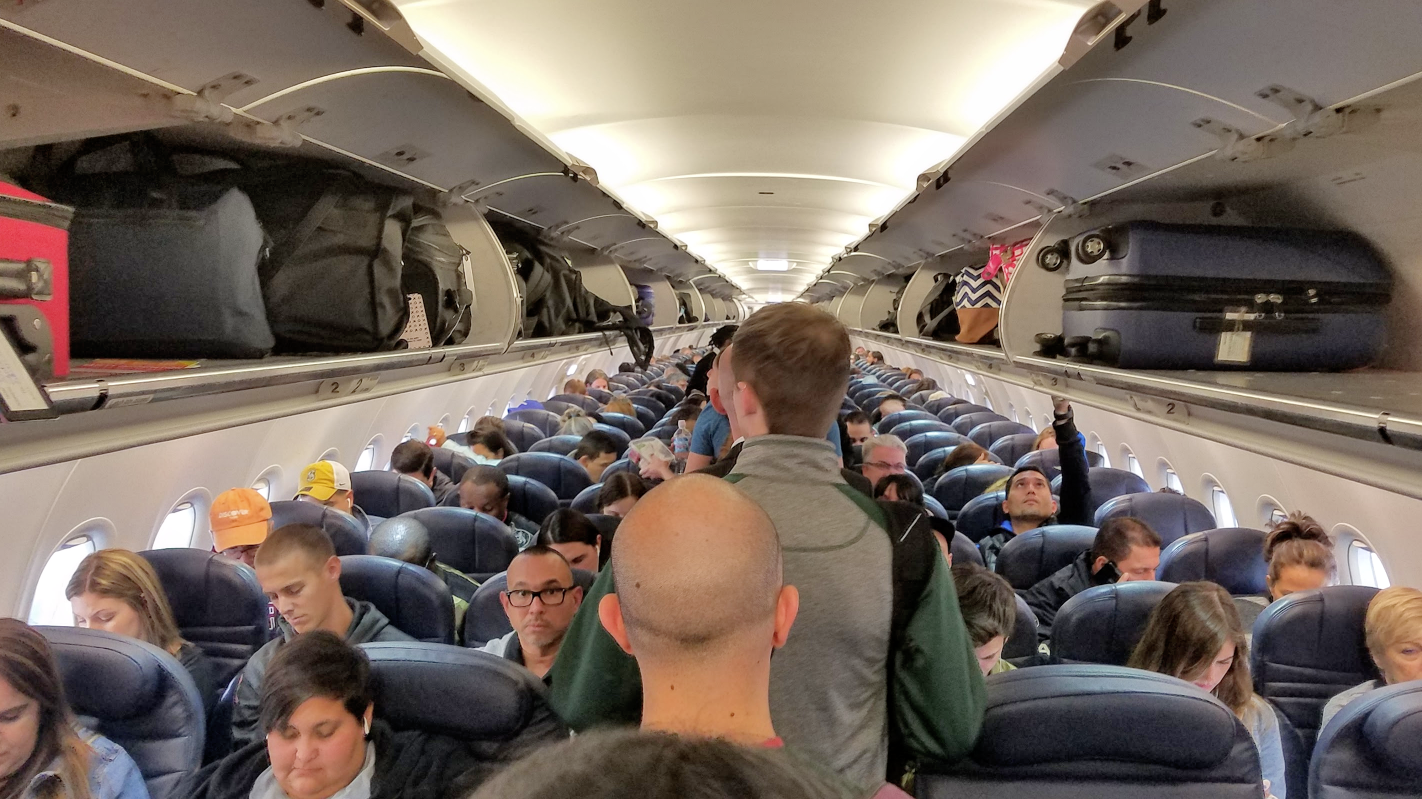Spirit Airlines filed for bankruptcy on Friday just five months after it had exited bankruptcy. The airline had restructured its debt but done little to fix its business, so running out of runway seemed inevitable from the start.
The airline has not walked through with the court what led them to bankruptcy – both what’s hurt their business, and what triggered them to file. They blame Southwest for making them lose money, and their aircraft lessor AerCap for pushing them back to the courthouse.

Spirit Says AerCap Pushed Them Into Bankruptcy
Last week, aircraft lessor AerCap sent a Termination Notice on 36 undelivered A320neo aircraft scheduled for delivery 2027 – 2028 and a Default Notice cover 37 planes in Spirit’s fleet. The Default Notice did not accelerate or terminate the in-service leases.
AerCap cited language defining default if “any proceedings, resolutions, filings or other steps are instituted or threatened with respect to…bankruptcy, liquidation, reorganization or protection from creditors… If instituted by [Spirit], the same will be an immediate Event of Default; if by another Person, an Event of Default if not dismissed within 60 days.”
Spirit says it was in full compliance with the leases – no overdue amounts, and they hadn’t filed bankruptcy! – and they plan to litigate here if they can’t successfully negotiate.
But there’s a $2.1 million termination fee per undelivered aircraft immediately payable for early termination. And this risked a cascade of actions by other counterparties since Spirit just didn’t have the money. They would have been required to disclose the default and termination notices in SEC 8-Ks. So they “had no choice but to quickly seek the protections of chapter 11.”
I’m not familiar enough with aircraft lease law, or how bankruptcy treats this, but Spirit has strong facts that they had not actually defaulted on the leases. Any one could see a bankruptcy coming, though, and whether that’s enough (versus an actual ‘threatened filing’) is something I’d love for subject matter experts to weigh in on.
They’re Losing Money Because Of Southwest Airlines
Spirit Airlines was in a downward spiral of losses when they filed for bankruptcy in 2024. They didn’t fundamentally transform their business coming out of that bankruptcy. However, they say that they’re back at the courthouse because of Southwest’s transformation plan to fix its own financial underperformance.
However, Spirit’s filing says that Southwest’s business model changes (e.g. bag fees, seat fees, expiring travel credits, basic economy) met customer resistance and they responded by slashing domestic pricing. That drove down yields industry-wide. Combined with industry overcapacity and still-weak U.S. business demand, Spirit’s revenue couldn’t grow.

Meanwhile, United, Delta and American matched Spirit’s fares with their own basic economy to fill empty seats while earning their profits from premium products and loyalty programs (mileage sales to banks).
That these things were happening in the industry is largely true. That’s a tough environment to be in for an airline with a damaged brand, products that haven’t met what consumers have wanted to buy post-pandemic, and a route network that hasn’t lined up with traveler demand. And it’s especially tough because Spirit’s costs have risen. Some of that is post-pandemic wage increases. Some of it is self-inflicted – not paying close attention to costs the way they once did (opening a new corporate campus last fall!).
Fight on the Spirit Airlines fight from Atlanta to Newark pic.twitter.com/gBr9jwImjz
— Atlanta Uncensored (@ATLUNCENSORED) July 23, 2021
Spirit also cites Pratt & Whitney engine problems grounding planes. However they also say they need to do less unprofitable flying. If those planes had been in the air, they’d have lost more money! Instead they’re due compensation from the engine manufacturer.
Meanwhile, other airlines faced similar headwinds. Frontier isn’t doing well, but they’re doing far better than Spirit!

How Spirit Plans To Turn Around Their Business
The plan is to “redesign its network” to focus on key markets like Fort Lauderdale, Orlando and Detroit with more frequencies and connectivity in focus cities, while shrinking their presence elsewhere.
They’ll use bankruptcy to shrink the fleet this time, renegotiate or reject expensive aircraft and engine leases, and shed expected heavy maintenance costs for planes they don’t keep.
Then they’ll lean into their new product bundles (First, Premium Economy, Value) to try to capture more consumers and upsell them.

Shrinking to profitability is hard, because it spreads fixed costs across fewer seats, but they don’t have a vision for how to deploy capacity economically so they probably have to do that. Plus, without significant financing they need to shed heavy maintenance exposure. That’ll help bring down costs.
It’s unclear what savings they’ll be able to get from lease renegotiations, since it could be more profitable to lease planes they actually do want to keep elsewhere.
As for continuing the pivot away from being a fee-based airline and more like a traditional carrier with product bundles, I’m not sure
- that the market needs another American Airlines or JetBlue, or
- why consumers will choose Spirit for their premium travel needs over competitors.
It’s been obvious since they filed bankruptcy last time that this was the direction they were headed in. It didn’t take an unreasonable aircraft lessor, or bad luck to actually face competition from other airlines, to push them back here.
- I wrote 9 months ago, when they filed for bankruptcy last time, that their turnaround plan made no sense. They weren’t really cutting costs, outside of restructuring debt. And their plan was to spend money to become a different, more premium, airline – under the same Spirit brand. In other words, to become more like American Airlines and JetBlue but not as good.
- When they emerged from bankruptcy I wrote that a return to the courthouse could be just around the corner. The airline hadn’t solved the problems that led it into bankruptcy in the first place.
- Indeed, the carrier was forced several times to warn that it might not survive as a going concern. They’d burned up all of their available credit lines, and their credit card processor was holding back up to $3 million a day from ticket sales as a hedge against their ceasing operations.
It’s not clear that Spirit knows who they want to be yet, other than a smaller low cost airline that tries to offer some of the services of its larger competitors but do that less well. And that may not be enough to overcome their brand and challenges.


“Spirit’s filing says that Southwest’s business model changes (e.g. bag fees, seat fees, expiring travel credits, basic economy) met customer resistance and they responded by slashing domestic pricing.”
Southwest’s prices seem higher than a year ago in the markets I fly. I don’t see anything that looks like slashed domestic pricing.
It sure doesn’t seem like Spirit has a business model that works in today’s market.
Southwest didn’t lower fares because of customer resistance. They needed to unbundle checked bags in order to offer fares that could compete with other airlines who offered those fares. Being able to offer lower fares was part and parcel of the reason to unbundle bag fees.
With the big 3 offering Basic Economy, Southwest had to respond and did, and now there is little room for Spirit. Allegiant has niche routes with little non-stop competition. What does Spirit have? There is non-stop competition on all their routes. If Spirit doesn’t have a cost advantage, how can they compete? Frontier may find itself in a similar position, and JetBlue already does.
Because of the demographic that Spirit and Frontier chased, they don’t have a valuable credit card program. Their cost advantage has eroded. They are getting squeezed.
That’s The Spirit!!!!
This is very interesting. It appears to suggest that SWAs rebuild is not working. They are having to lower prices to fill planes.
As I have said, WN has the financial resources to transform itself; other airlines do not.
and, it is once again important to note that AA has been the least profitable airline on a margin basis over the past 15 years.
NK’s falloff was pretty fast because they didn’t have the financial resources to navigate the changing industry while AA has been able to take on and pay more debt.
The business models run by Spirit, Frontier, and JetBlue don’t work. The US3 have figured out long ago how to compete with basic economy tickets and all the upsells and this has worked. Best NK can hope for is a merger with F9. B6 will inevitably be acquired by either UA or AA. Southwest will eventually be swallowed whole by Delta. Greedy hedge fund titans will make sure of that.
I’d say there is real macroeconomic distress (mostly caused by bad policy decisions by our Dear Leader and his minions, namely self-inflicted wounds like illegal tariffs, but also, the illegal rendition of human beings to offshore gulags, which kinda ‘kills’ travel to and within the USA by foreign nationals.)
And, that rot tends to start at the lowest end of the spectrum first (like, those that typically fly Spirit.)
Or… ignore all that TDS, and, yeah, just blame Southwest, or whatever. Good one.
@lavanderialarry who does AS go home with at 2am?
I can’t recall any “shrink to survive” in the airline industry that has worked. Does anyone remember a successful one?
1990
with all due respect, the gap between the haves and have nots in the US grew markedly during the easy money that started Jan 20, 2021. Inflation soared which hurt the little people the most; the wealthy and even middle class people adapted and many thrived. It may change but the economic trajectory that the US is on right now has not materially changed since THIS Jan 20.
The airline industry now is a byproduct of failed government policies – too much cash to the industry which slowed the natural restructuring that failing businesses have to do while reshaping consumer behavior – a much greater willingness to spend on higher quality products and experiences by the “haves” while the have-nots struggle just to get by.
NK catered to the lower tier and did not adapt. DL figured out long before covid that a premium strategy made sense and was already delivering industry leading profits. and DL has pushed labor costs up which DL can afford but most of the industry cannot; UA’s profits will be a whole lot less than they are now when they finally have to get around to settling w/ their half dozen outstanding labor contracts.
most of the industry is in play with DL and UA likely the only two that are on a sustainable path. UA talks alot about what it wants to gain out of industry failures while DL has been much more quiet but undoubtedly has multiple scenarios ready to go, not the least of which is to use its MRO license to take NK’s unflyable A320NEO family aircraft and refurb their engines while they wait for new cabin interiors. DL will grow somehow – they always do when someone else suffers but they don’t make near as much noise as UA does.
I feel for NK’s people but the good pilots and mechanics will quickly get snapped up along w/ planes if they stay in the US.
@Tim Dunn — I’ve read the ‘blame the prior administration(s)’ cop-out before.
No, this is not because people got a few checks from the government during the pandemic, including from both #45 and #46 administrations; if anything the corporate and small business (PPP) bailouts are more to blame, but, still, no, not really that either, at least not in 2025.
I also reject the premise that it’s merely #46’s antitrust enforcement preventing those merger(s) that is bringing them down. Again, today, NK could visit Palm Beach (they already fly to PBI/FLL, after all), ‘kiss the ring,’ pay the bribe, and #47 will grant your every wish!
So, what’s really happening is the poorest among us cannot afford hardly anything anymore, so they simply aren’t traveling. Yes, this all is bad for workers and consumers, and I ‘feel’ for both, always, since there will likely be less competition soon, and, if things get worse, then it won’t just be the ‘poor’ who aren’t traveling anymore… the real question is ‘why are people struggling’ and as I said above, bad policy, greed at the top, etc.
Or, one more time, ah, it’s that pesky Southwest, at it again… psh.
OMG. Can upper level Spirit management not take responsibility for any of their incompetence!? Just die already so that Frontier can follow quickly next. If you want to study a very well managed & mannered LCC then study Sun Country.
Personally, there is no way in this or any other lifetime, that I would fly on Spirit Airlines.. I feel sorry for the employees but incompetent management will never save them.
@American – you don’t know what you’re missing out on. Spirt First is actually not bad. You have to be okay with seats that don’t recline (I am) and no powerports (again, I am). In return, you get a first class seat for the price of coach, free booze and…wait for it…they have ramen noodles and far better snacks on board than the baskets on United and Delta. It ain’t fancy, but when you just gotta get there it’s not as bad as you would think, LOL!
Management decided to be the airline that flew the ghetto and the trailer park and when the stymies from COVID ran out and their core customer maxed out their 12 credit cards they no longer could be counted on, particularly if fares were increased. Frontier is headed to the same fate.
Planes are expensive to operate. Unless there additional revenue streams charging fares below the cost of operating the business only leads to bankruptcy.
1990
you and I agree that the previous administration’s antitrust decisions get far too much negative press – esp. from this site.
and, yes, far too many people are just getting by with the basics.
I do not believe you can argue that some of the excess cash that was dumped into the economy worked out but other parts of it did not. It was all excessive. It was needed at first. and only at first. but it kept coming and the damage of all of that “free” money can never be fixed.
specific to NK’s complaint, it ALWAYS comes down to the strongest in any “competition” are the ones that will be able to stick around.
WN’s financial problems did not just appear during the 5 months from when NK emerged from C11 #1. NK simply failed to consider all of the possibilities for how each of the struggling carriers might transform themselves. WN’s transformation story is not finished but they have deep enough pockets to outlast most of the carriers in the industry, including AA, if push comes to shove.
Spirit Airlines had every opportunity to sellout to Frontier and said NO. Absolutely the poorest management decision ever made. Oops, the CEO profited greatly. Another disregard to the share holders.
@Tim Dunn — We’re mostly on the same page. However, I’d bet on AA outlasting SW. And, Spirit is still flying; it’s not liquidation, yet. I hope they can resize and continue, even if in a new form.
If you want to break some actual news, Prashant Sharma is out as VP of Loyalty at Skypesos. Likely due to ethics complaints.
I’ve had far better experiences on Spirit than American and I will be sad to see them go. They’re in the middle of an identity crisis that they can’t afford.
I don’t see how Jetblue can be lumped in with Spirit and Southwest. Jetblue always let you reserve your seat and had nice seats, snacks, and an IFE. Spirit has severe branding issues from its days of harsh irregular ops and “gotchas” at the gate plus the crowd on Spirit is nasty. I would think twice about flying “business” class on Spirit versus regular economy on United but I’d consider flying economy on Jetblue better than flying economy on United.
McDonald’s CEO just said this morning that the US has a two-tiered economy. People making over 100k or have substantial stock holdings are doing ok but the rest of those who don’t are doing poorly -and their purchases are down double digits at McD’s.
The same thing is happening w/ airlines.
DL figured out well before covid that a premium strategy made sense; UA embraced it during covid. Many of the low cost carriers are unable to “premiumify” and they are paying the price.
Schadenfreude is alive and well.
no, Ghost, companies pay executives to be able to look far enough down the road to adapt to whatever might happen. NK’s execs, sadly, did not have the foresight to see 5 months down the road.
and since WN had already announced its plans to change its product, NK can’t use the excuse that “WN did it to me”
“People making over 100k or have substantial stock holdings are doing ok but the rest of those who don’t are doing poorly”
The solution to this is obvious. Have a percentage of the money put into Social Security used to buy stocks or ETFs that track the S&P500 and have overages above the low amount credited to the standard Social Security funds available for distribution to those who take advantage of such a plan. The reason Social Security is in trouble is due to the Social Security funds not being invested in a reasonable fashion so Congress can use the funds to spend as they wish. Then anybody who pays into Social Security would have stock holdings through their Social Security funds.
Social Security started out as a many pay in and a lot fewer get a payout scheme due to the age requirements. As health improved and people started living longer, more was required of Social Security. Politicians had other ideas and “borrowed” the funds, paying only a low interest rate. The money was used and wasted on many things. If the funds had been invested correctly Social Security would not be in trouble and would instead have a large surplus to boost the economy.
Those who do not invest correctly are just following their Uncle Sam.